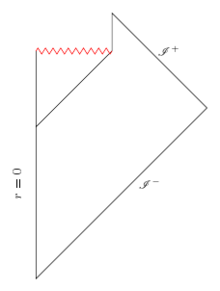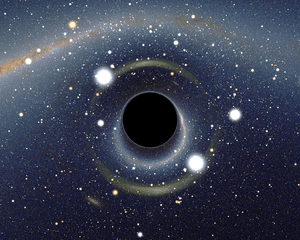Black hole information paradox

The black hole information paradox[1] results from the combination of quantum mechanics and general relativity. It suggests that physical information could permanently disappear in a black hole, allowing many physical states to devolve into the same state. This is controversial because it violates a commonly assumed tenet of science—that in principle complete information about a physical system at one point in time should determine its state at any other time.[2][3] A fundamental postulate of quantum mechanics is that complete information about a system is encoded in its wave function up to when the wave function collapses. The evolution of the wave function is determined by a unitary operator, and unitarity implies that information is conserved in the quantum sense. This is the strictest form of determinism.
Principles in action
There are two main principles in play:
- Quantum determinism means that given a present wave function, its future changes are uniquely determined by the evolution operator.
- Reversibility refers to the fact that the evolution operator has an inverse, meaning that the past wave functions are similarly unique.
The combination of the two means that information must always be preserved.
Starting in the mid-1970s, Stephen Hawking and Jacob Bekenstein put forward theoretical arguments based on general relativity and quantum field theory that not only appeared to be inconsistent with information conservation but was not accounting for the information loss and state no reason for it. Specifically, Hawking's calculations[4] indicated that black hole evaporation via Hawking radiation does not preserve information. Today, many physicists believe that the holographic principle (specifically the AdS/CFT duality) demonstrates that Hawking's conclusion was incorrect, and that information is in fact preserved.[5] In 2004 Hawking himself conceded a bet he had made, agreeing that black hole evaporation does in fact preserve information.
Hawking radiation

In 1975, Stephen Hawking and Jacob Bekenstein showed that black holes should slowly radiate away energy, which poses a problem. From the no-hair theorem, one would expect the Hawking radiation to be completely independent of the material entering the black hole. Nevertheless, if the material entering the black hole were a pure quantum state, the transformation of that state into the mixed state of Hawking radiation would destroy information about the original quantum state. This violates Liouville's theorem and presents a physical paradox.
More precisely, if there is an entangled pure state, and one part of the entangled system is thrown into the black hole while keeping the other part outside, the result is a mixed state after the partial trace is taken into the interior of the black hole. But since everything within the interior of the black hole will hit the singularity within a finite time, the part which is traced over partially might disappear completely from the physical system.
Hawking remained convinced that the equations of black-hole thermodynamics together with the no-hair theorem led to the conclusion that quantum information may be destroyed. This annoyed many physicists, notably John Preskill, who bet Hawking and Kip Thorne in 1997 that information was not lost in black holes. The implications that Hawking had opened led to a "battle" where Leonard Susskind and Gerard 't Hooft publicly 'declared war' on Hawking's solution, with Susskind publishing a popular book, The Black Hole War, about the debate in 2008. (The book carefully notes that the "war" was purely a scientific one, and that at a personal level, the participants remained friends.[6]) The solution to the problem that concluded the battle is the holographic principle, which was first proposed by 't Hooft but was given a precise string theory interpretation by Susskind. With this, "Susskind quashes Hawking in [the] quarrel over quantum quandary".[7]
There are various ideas about how the paradox is solved. Since the 1997 proposal of the AdS/CFT correspondence, the predominant belief among physicists is that information is preserved and that Hawking radiation is not precisely thermal but receives quantum corrections. Other possibilities include the information being contained in a Planckian remnant left over at the end of Hawking radiation or a modification of the laws of quantum mechanics to allow for non-unitary time evolution.
In July 2004, Stephen Hawking published a paper presenting a theory that quantum perturbations of the event horizon could allow information to escape from a black hole, which would resolve the information paradox.[8] His argument assumes the unitarity of the AdS/CFT correspondence which implies that an AdS black hole that is dual to a thermal conformal field theory. When announcing his result, Hawking also conceded the 1997 bet, paying Preskill with a baseball encyclopedia "from which information can be retrieved at will." However, Thorne remains unconvinced of Hawking's proof and declined to contribute to the award.
According to Roger Penrose, loss of unitarity in quantum systems is not a problem: quantum measurements are by themselves already non-unitary. Penrose claims that quantum systems will in fact no longer evolve unitarily as soon as gravitation comes into play, precisely as in black holes. The Conformal Cyclic Cosmology advocated by Penrose critically depends on the condition that information is in fact lost in black holes. This new cosmological model might in future be tested experimentally by detailed analysis of the cosmic microwave background radiation (CMB): if true the CMB should exhibit circular patterns with slightly lower or slightly higher temperatures. In November 2010, Penrose and V. G. Gurzadyan announced they had found evidence of such circular patterns, in data from the Wilkinson Microwave Anisotropy Probe (WMAP) corroborated by data from the BOOMERanG experiment.[9] The significance of the findings was subsequently debated by others.
Main approaches to the solution of the paradox
Information is irretrievably lost[10][11]
- Advantage: Seems to be a direct consequence of relatively non-controversial calculation based on semiclassical gravity.
- Disadvantage: Violates unitarity, as well as energy conservation or causality.
Information gradually leaks out during the black-hole evaporation[10][11]
- Advantage: Intuitively appealing because it qualitatively resembles information recovery in a classical process of burning.
- Disadvantage: Requires a large deviation from classical and semiclassical gravity (which do not allow information to leak out from the black hole) even for macroscopic black holes for which classical and semiclassical approximations are expected to be good approximations.
Information suddenly escapes out during the final stage of black-hole evaporation[10][11]
- Advantage: A significant deviation from classical and semiclassical gravity is needed only in the regime in which the effects of quantum gravity are expected to dominate.
- Disadvantage: Just before the sudden escape of information, a very small black hole must be able to store an arbitrary amount of information, which violates the Bekenstein bound.
Information is stored in a Planck-sized remnant[10][11]
- Advantage: No mechanism for information escape is needed.
- Disadvantage: To contain the information from any evaporated black hole, the remnants would need to have an infinite number of internal states. It has been argued that it would be possible to produce an infinite amount of pairs of these remnants since they are small and indistinguishable from the perspective of the low-energy effective theory.[12]
Information is stored in a baby universe that separates from our own universe.[11][13]
- Advantage: This scenario is predicted by the Einstein–Cartan theory of gravity which extends general relativity to matter with intrinsic angular momentum (spin). No violation of known general principles of physics is needed.
- Disadvantage: It is difficult to test the Einstein–Cartan theory because its predictions are significantly different from general-relativistic ones only at extremely high densities.
Information is encoded in the correlations between future and past[14][15]
- Advantage: Semiclassical gravity is sufficient, i.e., the solution does not depend on details of (still not well understood) quantum gravity.
- Disadvantage: Contradicts the intuitive view of nature as an entity that evolves with time.
See also
- AdS/CFT correspondence
- Black hole complementarity
- Cosmic censorship hypothesis
- Firewall (physics)
- Fuzzball (string theory)
- Holographic principle
- List of paradoxes
- Maxwell's Demon
- Thorne–Hawking–Preskill bet
- No-hair theorem
References
- ↑ The short form "ínformation paradox" is also used for the Arrow information paradox.
- ↑ Hawking, Stephen (2006). The Hawking Paradox. Discovery Channel. Retrieved 13 August 2013.
- ↑ Overbye, Dennis (12 August 2013). "A Black Hole Mystery Wrapped in a Firewall Paradox". New York Times. Retrieved 12 August 2013.
- ↑ Hawking, Stephen (1 August 1975). "Particle Creation by Black Holes". Commun. Math. Phys. 43 (3): 199–220. Bibcode:1975CMaPh..43..199H. doi:10.1007/BF02345020. Retrieved 13 August 2013.
- ↑ Barbón, J. L. F. "Black holes, information and holography" J. Phys.: Conf. Ser. 171 01 (2009) doi:10.1088/1742-6596/171/1/012009 http://iopscience.iop.org/1742-6596/171/1/012009 p.1: "The most important departure from conventional thinking in recent years, the holographic principle...provides a definition of quantum gravity...[and] guarantees that the whole process is unitary."
- ↑ Susskind, Leonard (2008-07-07). The Black Hole War: My Battle with Stephen Hawking to Make the World Safe for Quantum Mechanics (in English). Little, Brown. p. 10. ISBN 9780316032698. Retrieved 2015-04-07.
It was not a war between angry enemies; indeed the main participants are all friends. But it was a fierce intellectual struggle of ideas between people who deeply respected each other but also profoundly disagreed.
- ↑ http://richarddawkins.net/articles/2846
- ↑ Baez, John. "This Week's Finds in Mathematical Physics (Week 207)". Retrieved 2011-09-25.
- ↑ Gurzadyan, V. G.; Penrose, R. (2010). "Concentric circles in WMAP data may provide evidence of violent pre-Big-Bang activity" 1011. p. 3706. arXiv:1011.3706. Bibcode:2010arXiv1011.3706G.
- ↑ 10.0 10.1 10.2 10.3 Giddings, Steven B. (1995). "The black hole information paradox". Particles, Strings and Cosmology. Johns Hopkins Workshop on Current Problems in Particle Theory 19 and the PASCOS Interdisciplinary Symposium 5. arXiv:hep-th/9508151.
- ↑ 11.0 11.1 11.2 11.3 11.4 Preskill, John (1992). Do Black Holes Destroy Information?. International Symposium on Black Holes, Membranes, Wormholes, and Superstrings. arXiv:hep-th/9209058.
- ↑ Giddings, Steven B. (1998). "Comments on information loss and remnants". Phys Rev D. arXiv:hep-th/9310101. Bibcode:1994PhRvD..49.4078G. doi:10.1103/PhysRevD.49.4078.
- ↑ Nikodem J. Popławski (2010). "Cosmology with torsion: An alternative to cosmic inflation". Physics Letters B 694 (3): 181–185. arXiv:1007.0587. Bibcode:2010PhLB..694..181P. doi:10.1016/j.physletb.2010.09.056.
- ↑ Hartle, James B. (1998). "Generalized Quantum Theory in Evaporating Black Hole Spacetimes". Black Holes and Relativistic Stars: 195. arXiv:gr-qc/9705022. Bibcode:1998bhrs.conf..195H.
- ↑ Nikolic, Hrvoje (2009). "Resolving the black-hole information paradox by treating time on an equal footing with space". Physics Letters B (Phys. Lett.) 678 (2): 218–221. arXiv:0905.0538. Bibcode:2009PhLB..678..218N. doi:10.1016/j.physletb.2009.06.029.
External links
- Black Hole Information Loss Problem, a USENET physics FAQ page
- Preskill, John (1992). "Do black holes destroy information?". An international symposium on Black Holes: 22. arXiv:hep-th/9209058. Bibcode:1993bhmw.conf...22P. Discusses methods of attack on the problem, and their apparent shortcomings.
- Report on Hawking's 2004 theory at New Scientist
- Report on Hawking's 2004 theory at Nature
- Hawking, S. W. (July 2005), Information Loss in Black Holes, arxiv:hep-th/0507171. Stephen Hawking's purported solution to the black hole unitarity paradox.
- Hawking and unitarity: an up-to-date discussion of the information loss paradox and Stephen Hawking's role in it
- The Hawking Paradox - BBC Horizon documentary (2005)
- "Horizon" The Hawking Paradox at the Internet Movie Database
- A Black Hole Mystery Wrapped in a Firewall Paradox
| ||||||||||||||||||||||||||||||||||||||||
| ||||||||||||||||||||||||||||||||||||||||||
| ||||||||||||||||||||||||||||
